DotNext 2019 Piter: small report
On May 15-16, the DotNext 2019 Piter conference was held. The weather in St. Petersburg was unusually warm. The townspeople looked incredulously at the strange yellow ball in the unusually blue sky and still could not decide whether it was time to switch to a summer coat. And the congress center of the Park Inn Pulkovskaya opened the doors for visitors to the biggest event in the Russian dotnet. We remember how it was.
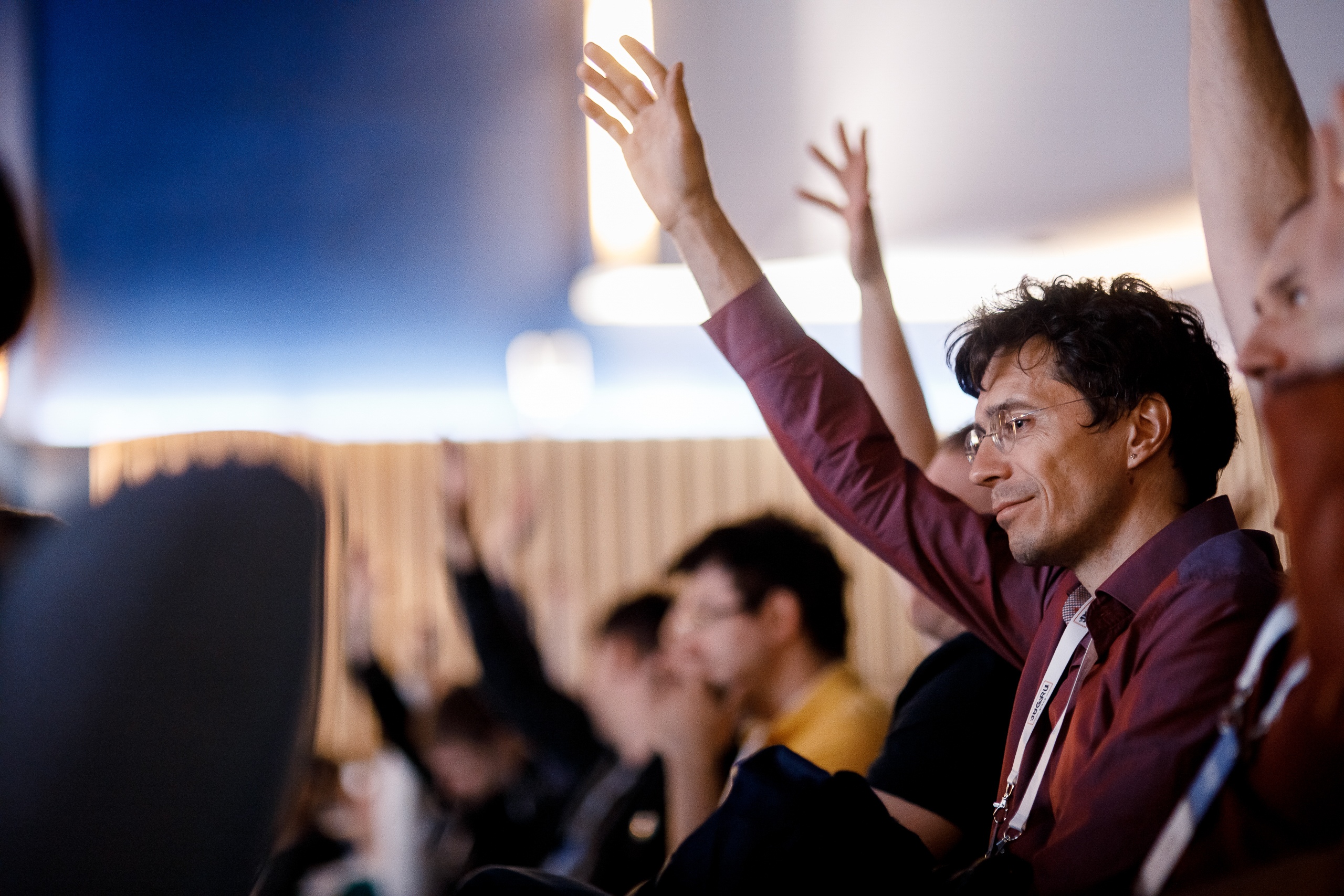
Many, I think, have already noticed that DotNext is becoming more and more tolerant to different directions. This time there was a place for architecture, trends, and just good practitioners, which are so often lacking in work. “But what about hardcore ?!” exclaimed hardcore lovers and waved tomatoes. I hasten to reassure, everything is in order with hardcore, it will always have a controlling stake.
Let me remind you that the full list of reports is still here , in the same place after a while there will be presentations. As for the video, those who filled out the feedback form should have received the link. The rest of the lucky bit less and have to wait until the video will be posted in open access. This usually happens closer to the next conference, which, by the way, will be held on November 6-7 in Moscow, in the WTC Congress Center. But decryption of some reports will appear on the site in the summer, do not miss it!
')
Also, there will definitely be a traditional post from the TOP-10 reports, and we will know the opinion of the majority of participants, but for now I’ll briefly tell you which ones I personally remember.
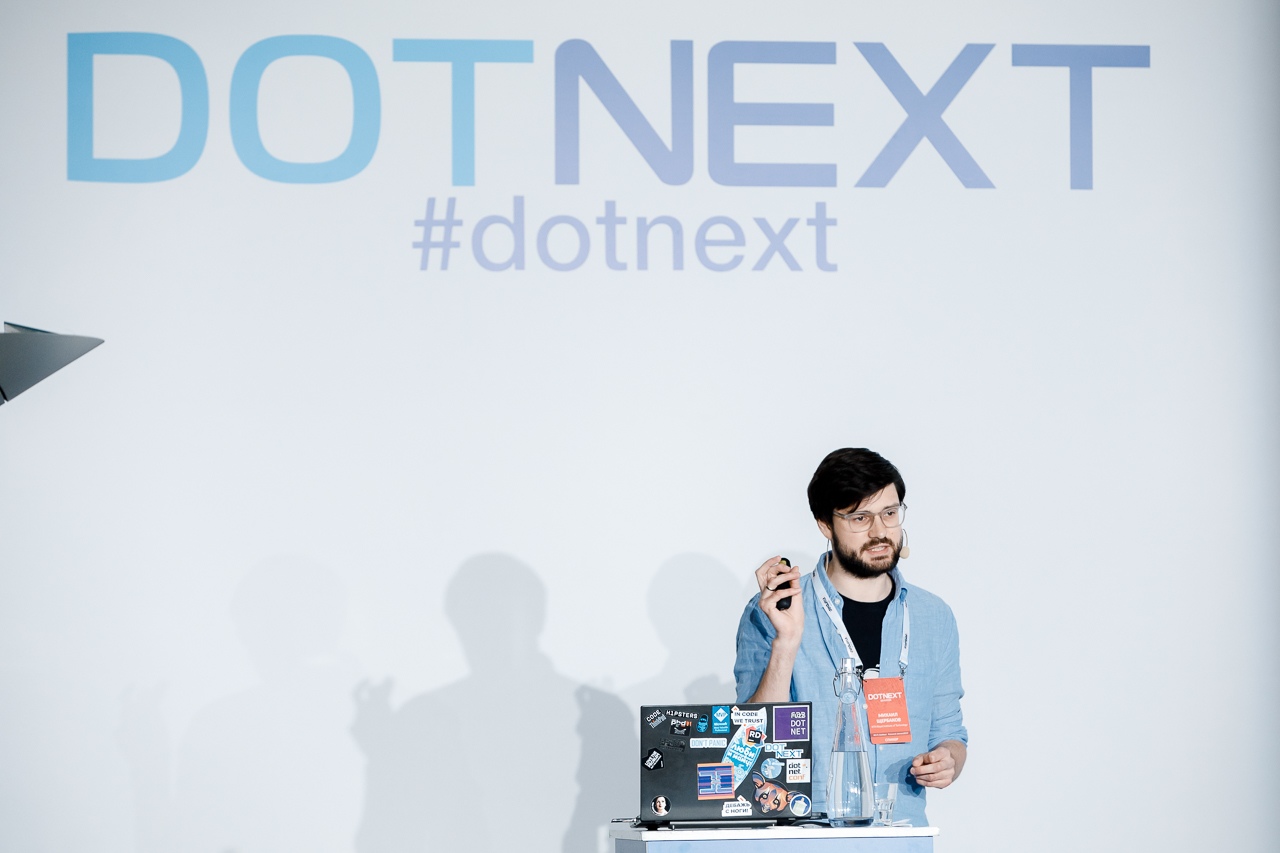
Security specialists are always a commodity piece. And such that both deeply, and actually, and the hall did not fall asleep - and at all in the afternoon with fire. Michael put the topic of vulnerabilities in deserializers on the shelves and shared best practices on how to write deserialization safely.

Eugene made his debut on DotNext a year ago in St. Petersburg with a report on exceptions, immediately took the first lines of the ratings and now the third conference in a row delivers guts to yourtable court. I often speak out as an opponent in debates about the usefulness of studying low-level details. After all, for the most part they are freaks out at the zoo. But for the contour infrastructure team, where Zhenya works, hardcore is life, and life is hardcore. This time, he spoke about the features of working with multithreading in .NET, elegantly combining theory with practical cases that his team decided.

Konstantin continues to tell the story of the monolith cut, which began last fall at DotNext 2018 Moscow. An excellent report about the practical application of DDD on large applications. Separately, I want to note that over the past six months Kostya has pumped heavily as a speaker.
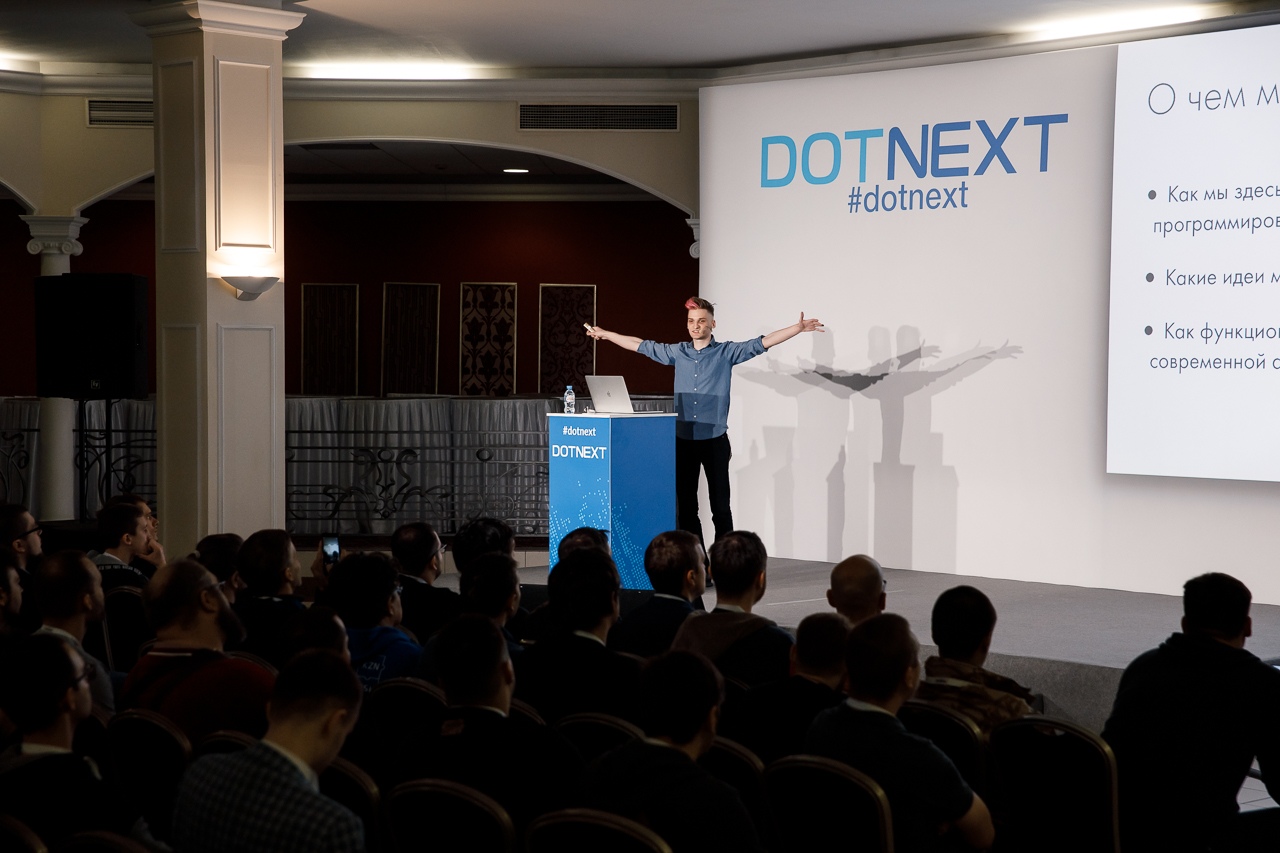

Why did I put two reports next to each other? The functional paradigm is flourishing. More and more features come to C # from the functional world. And both reports about building bridges between paradigms. About how here and now, without switching to F # or, especially, Haskell, to use the advantages that are provided by the functional approach. And this is not only thread safety and scalability, but also, for example, the expressiveness of the code (hello, DDD). In my opinion, the report of Roman was more solid and light, with traditional jokes and trolling. But to argue with yourself is difficult, so the paradigm confrontation is more clearly revealed in the doubles report. And although it is more difficult to prepare such a report by an order of magnitude, Vagif and Maxim got cool.
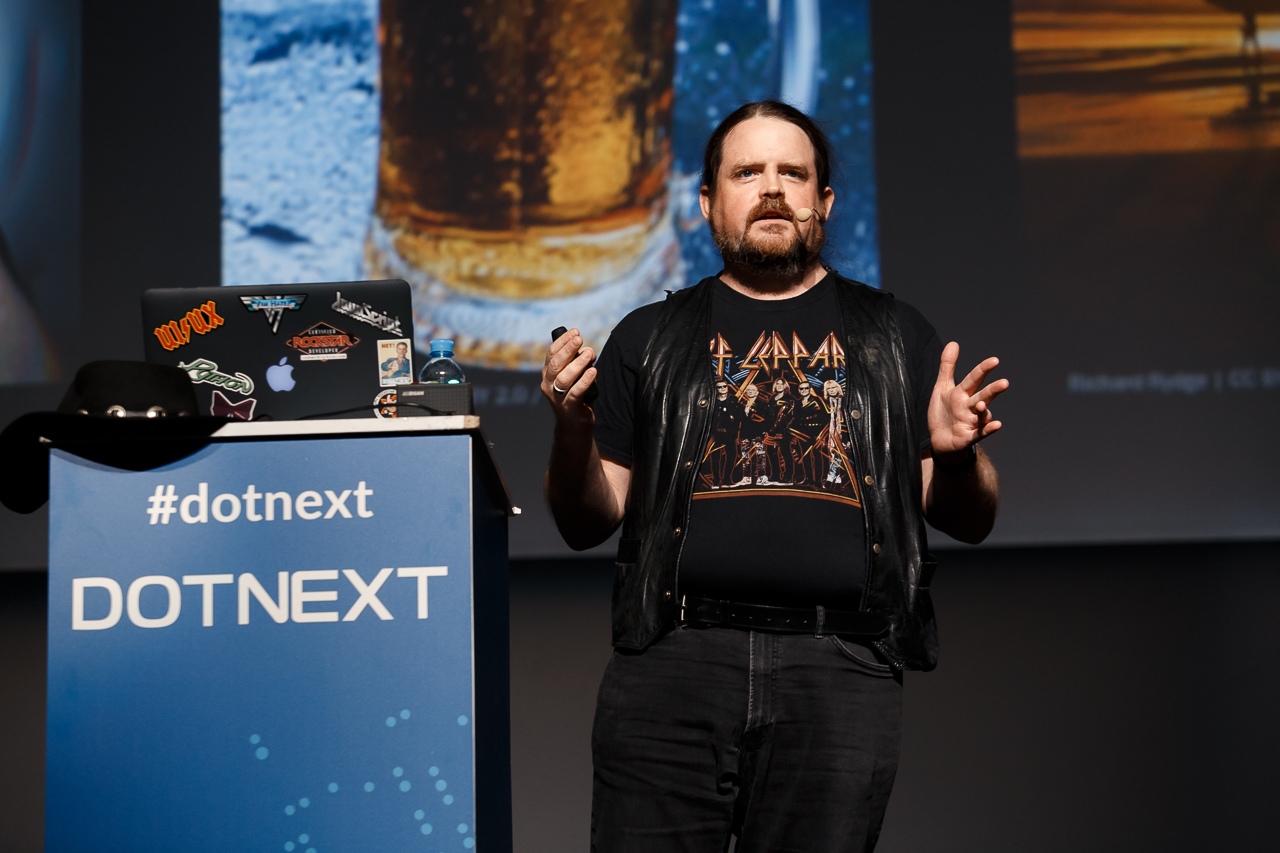
He closed the keyout program from Dylan Beatty. And this is very correct. Dylan as a magician pulls out of the hat (she won, on the left of the photo) pieces of a mosaic in the form of memes, code, news, facts. And then, when you least expect it, op! magic! and the puzzle develops into the Big Philosophical Thought.
Usually on reports they try to leave 5-10 minutes for questions from the audience, but sometimes there is so much material that there is not even that. Fortunately, each room has its own discussion zone, in which the speaker and all those who wish to move after the report. You can ask what is called “not for protocol” questions, but you can also ask for an autograph or a photo.

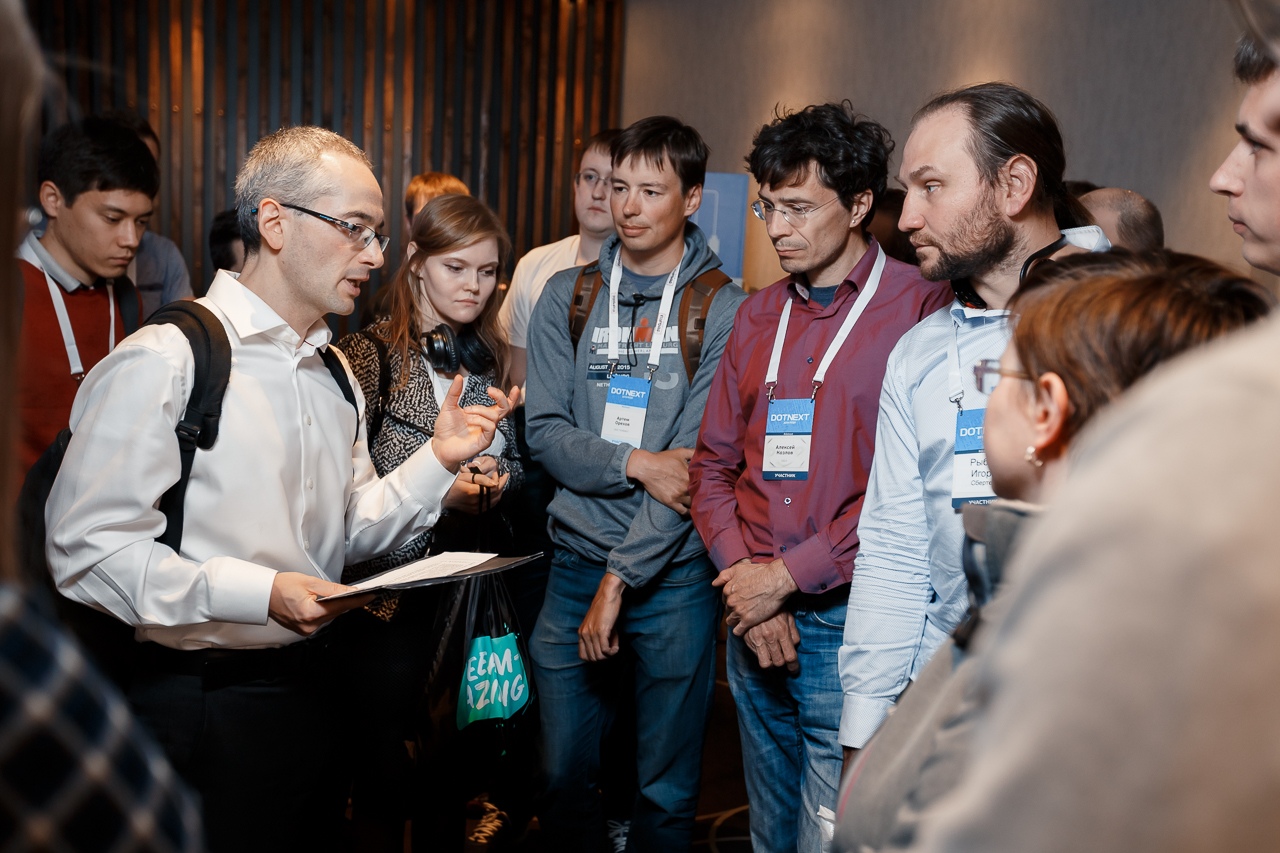
All the free space between the halls is occupied by the stands of the partners.
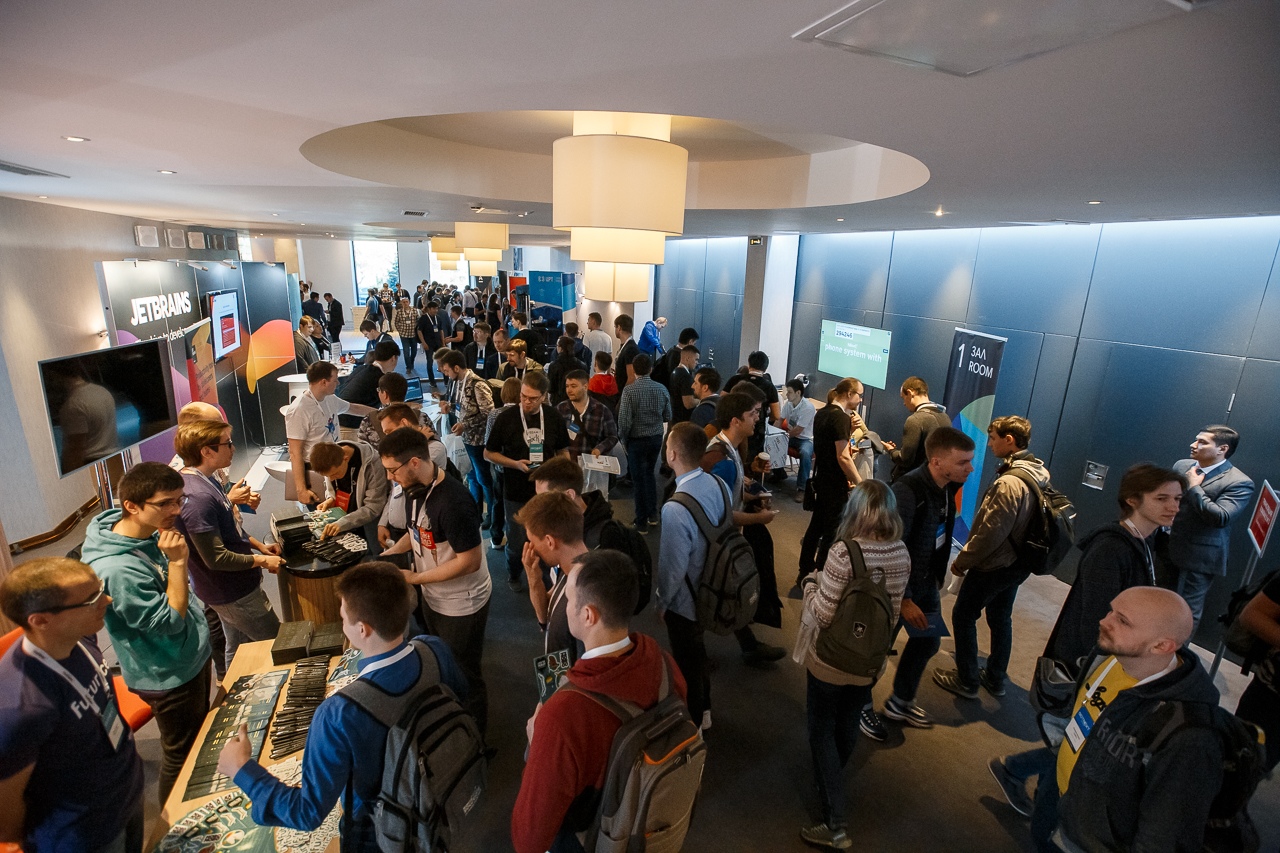
A dozen companies have pleased the participants with activities: quests, quizzes, lotteries and, of course, puzzles, where without them.
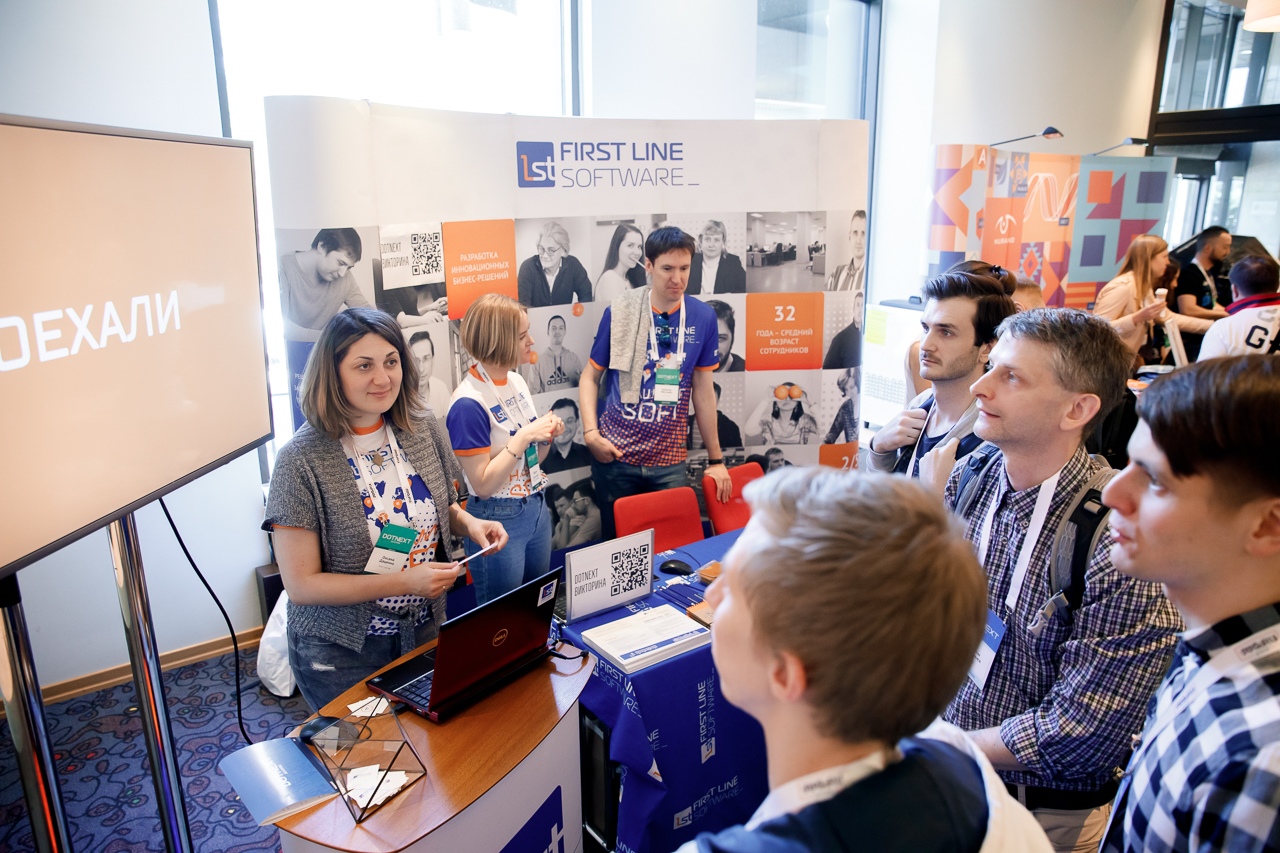
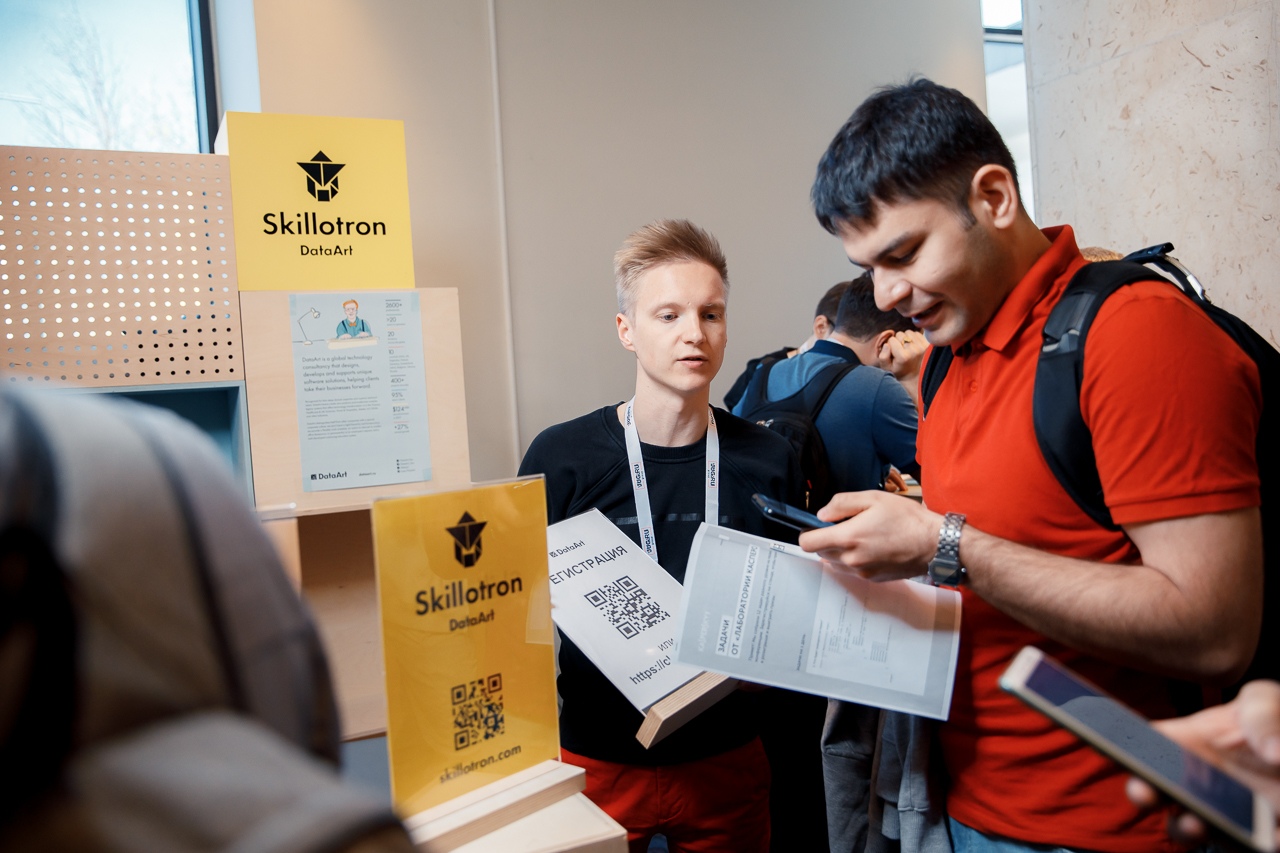
Murano Software treated everyone to ice cream.
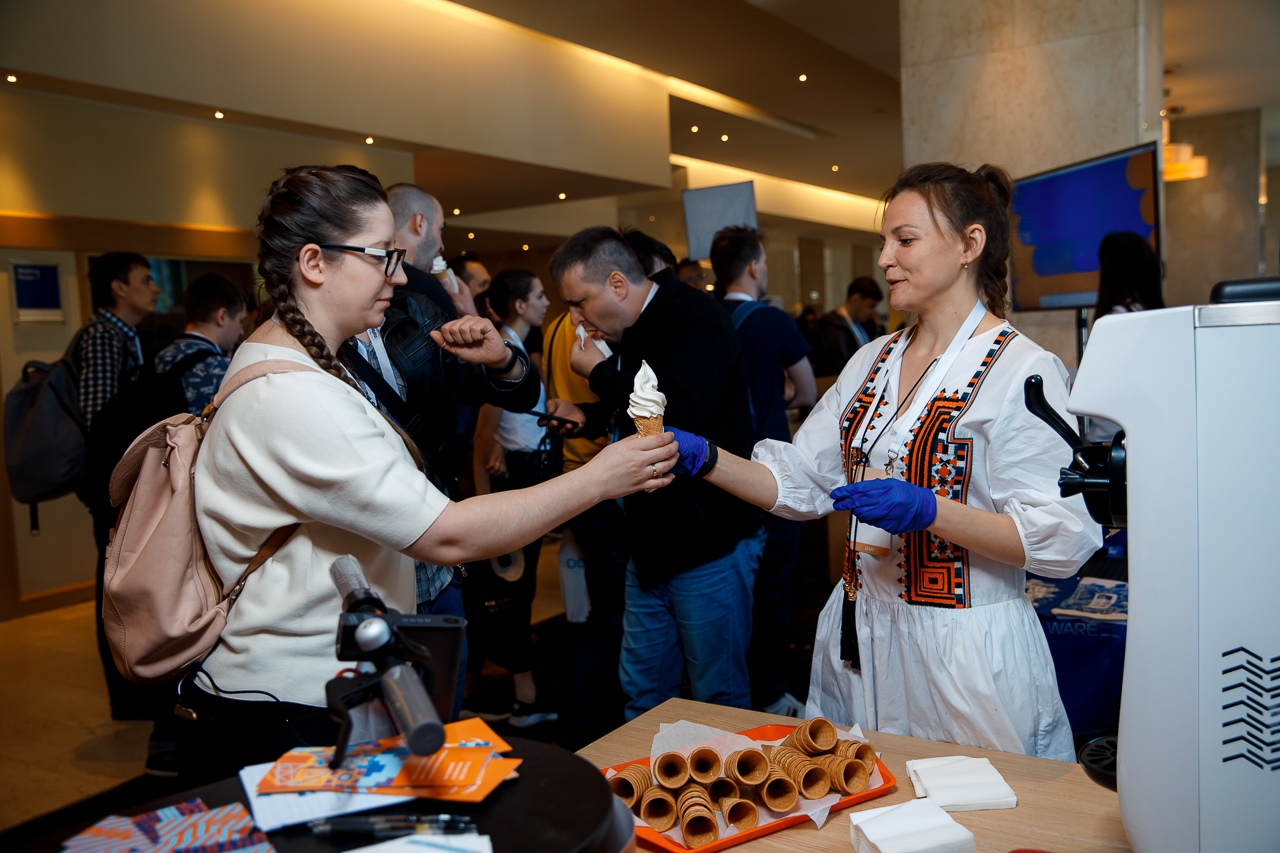
EPAM brought air hockey and pinball.
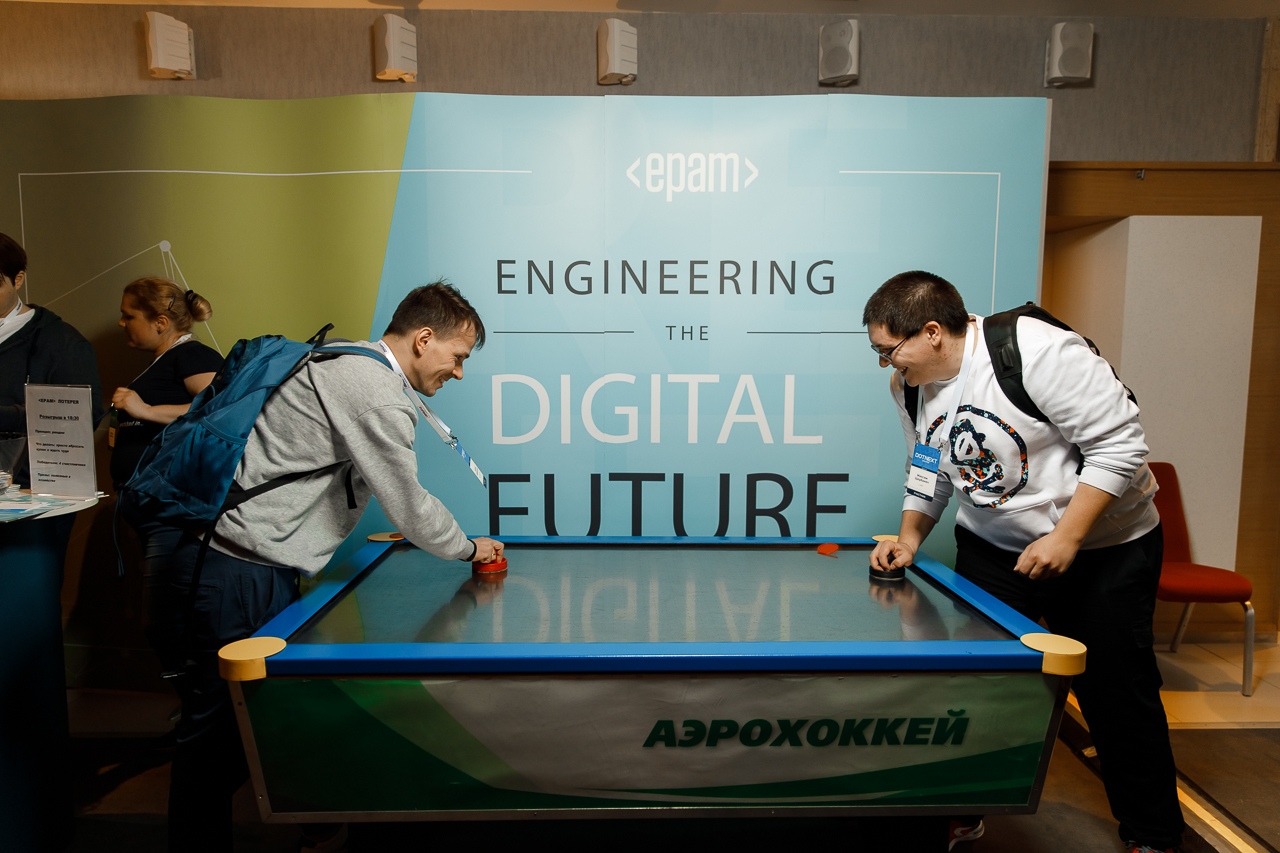

And Arcadia had something alien at all.
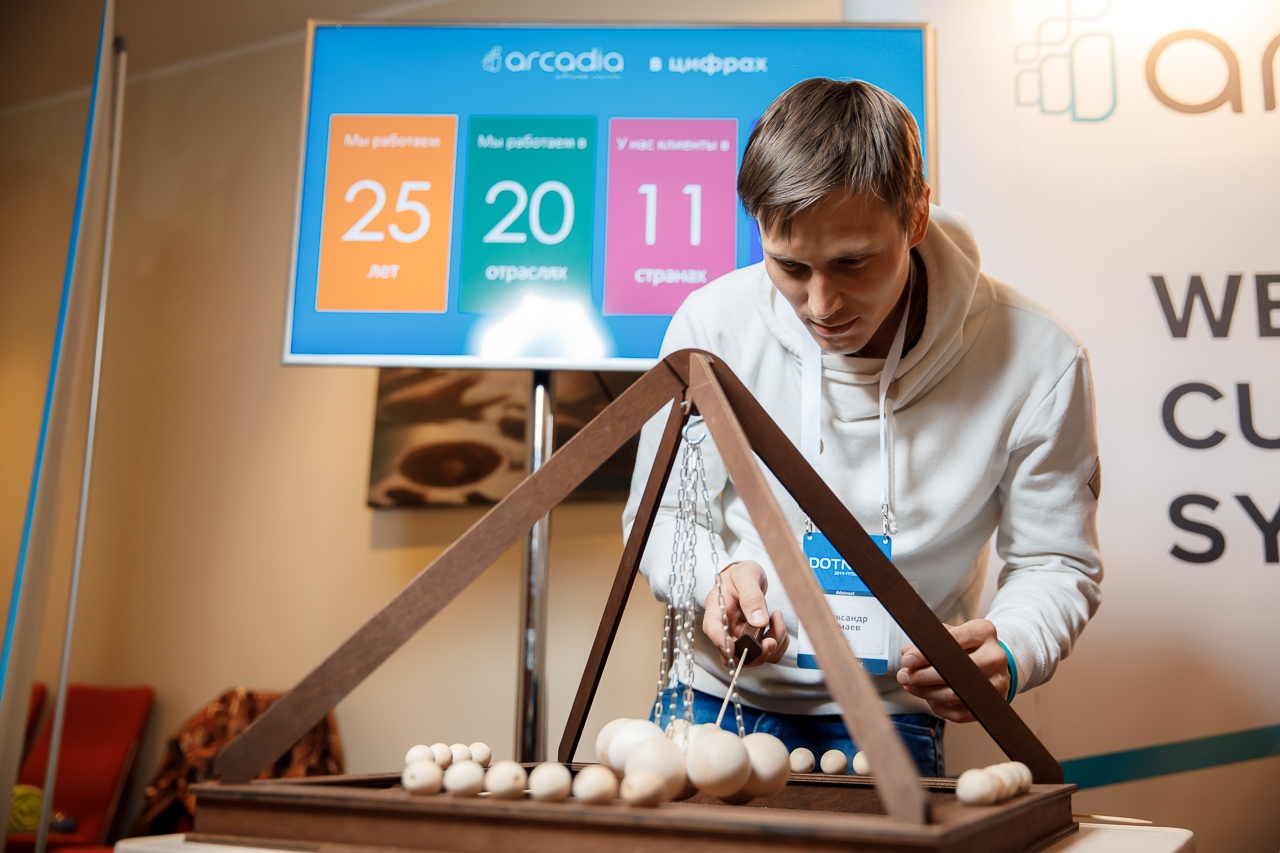
Demo Stage is a separate area where live reports were given by partners, prize draws were also held there.


At the stand of the All-Russian association .NET-communities DotNetRu had its own extensive program .
At the round tables, everything from Avalonia to DDD was discussed.

Listened to the reports.

And, of course, they played prizes in a quiz and quest.
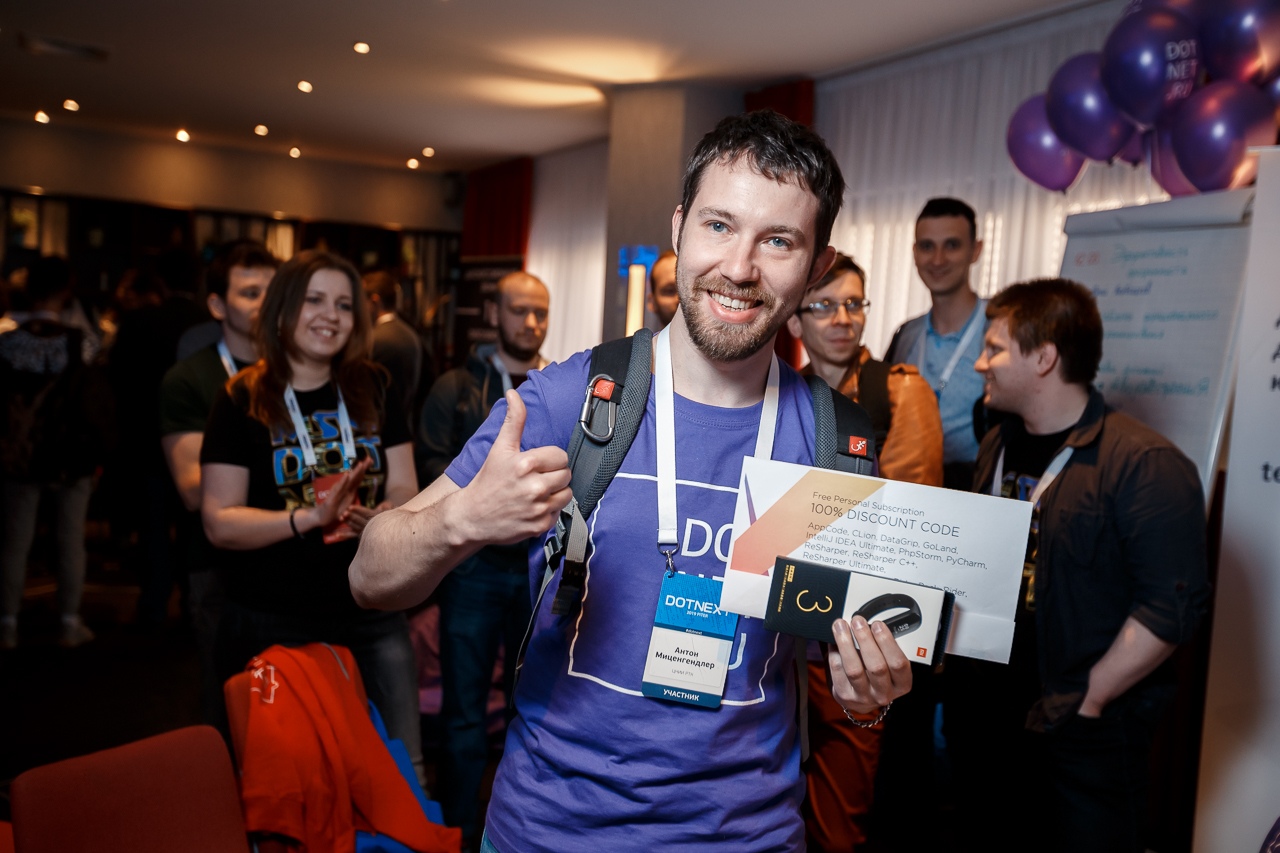
While the future of ASP.NET was discussed at the first BOFE, a hot discussion about .NET 5 flared up at the second: what is new in it, how Mono will live now and why Microsoft does not plan to support CoreRT. Participants also shared their experiences (both positive and not-so) of moving from the classic .NET Framework to the .NET Core.
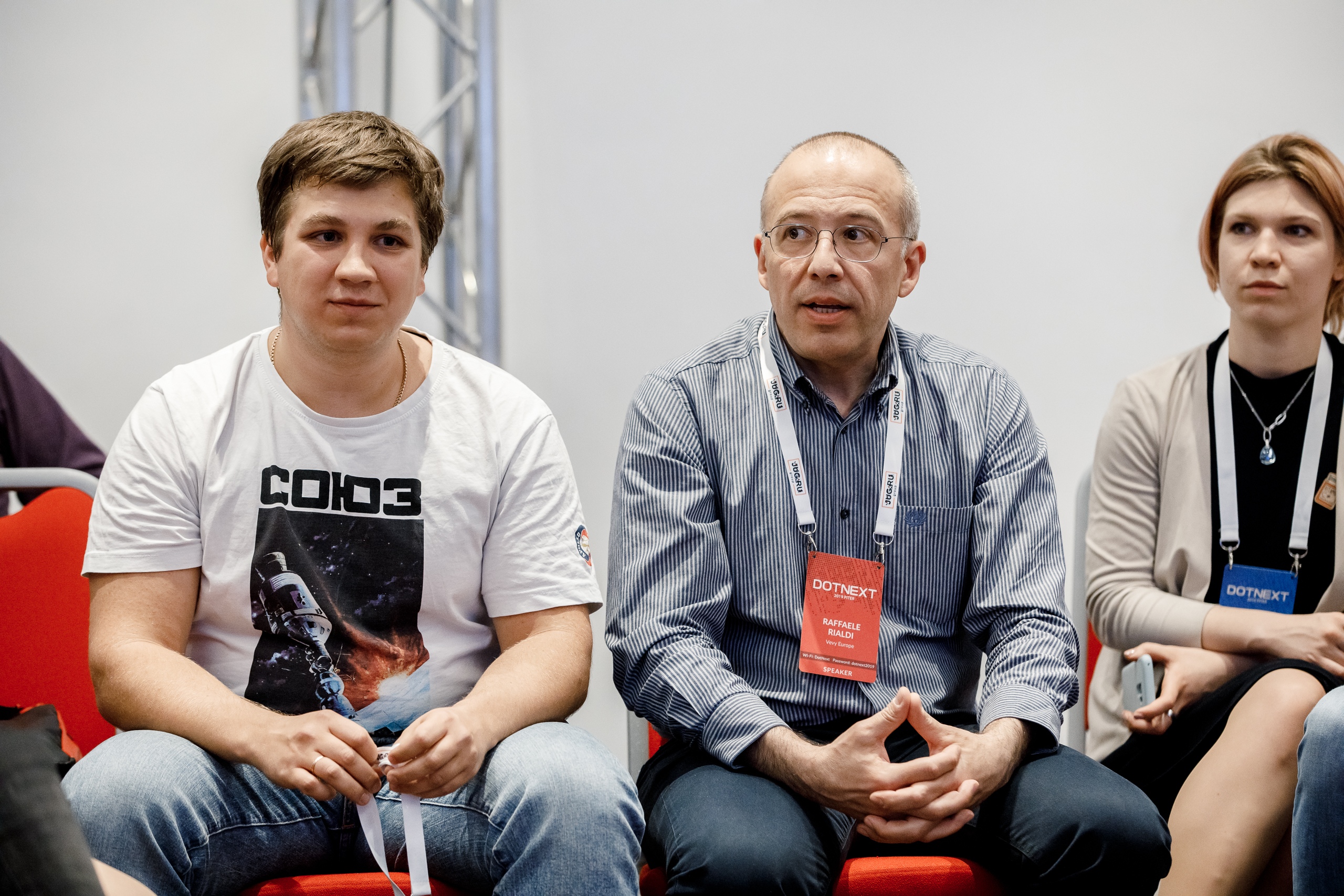
No less heated discussions were held at this time in the banquet hall.
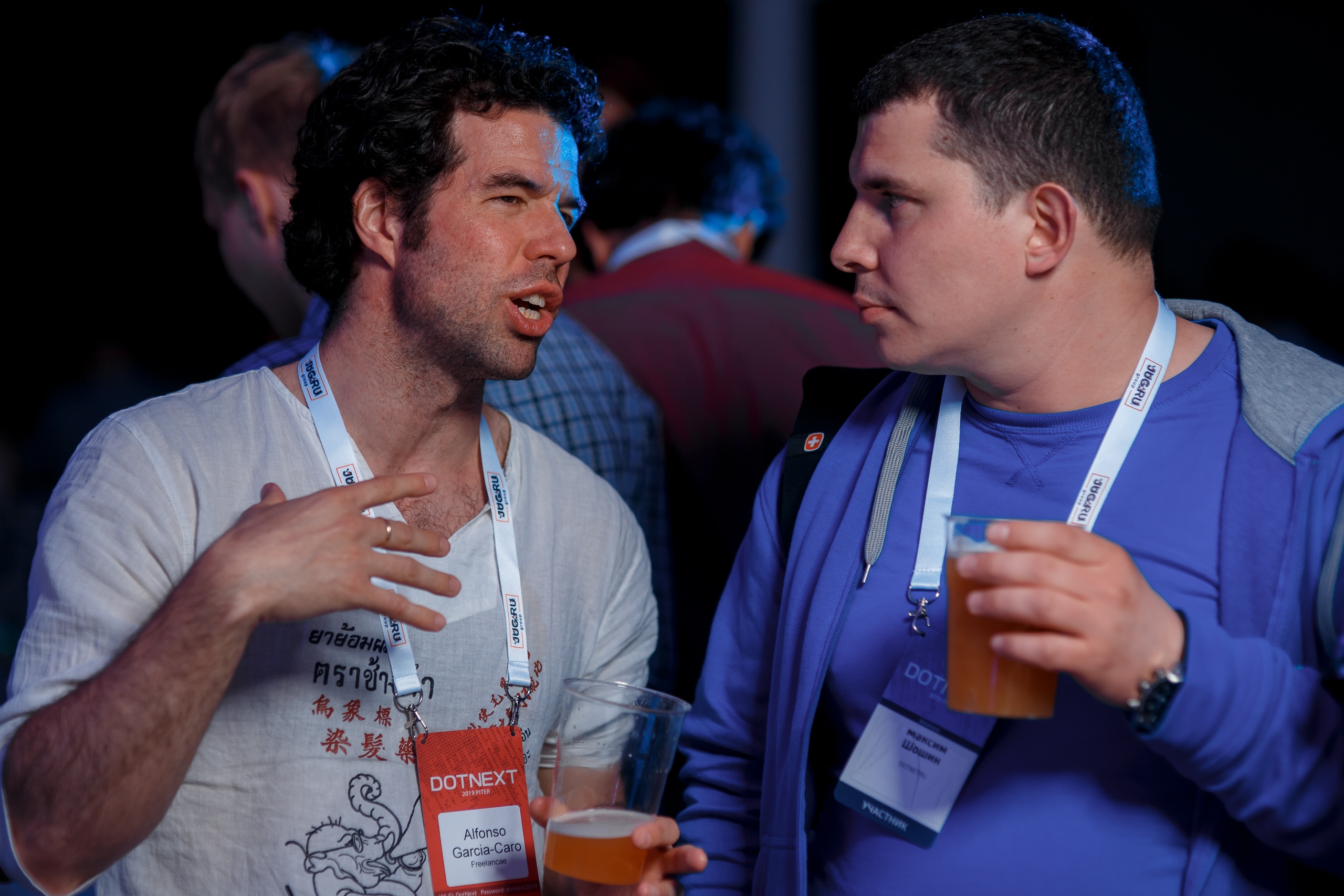
But the main event of the party was the traditional live performance of DotNext speakers Dylan Beatty, Vagif Abilov and Maxim Arshinov.


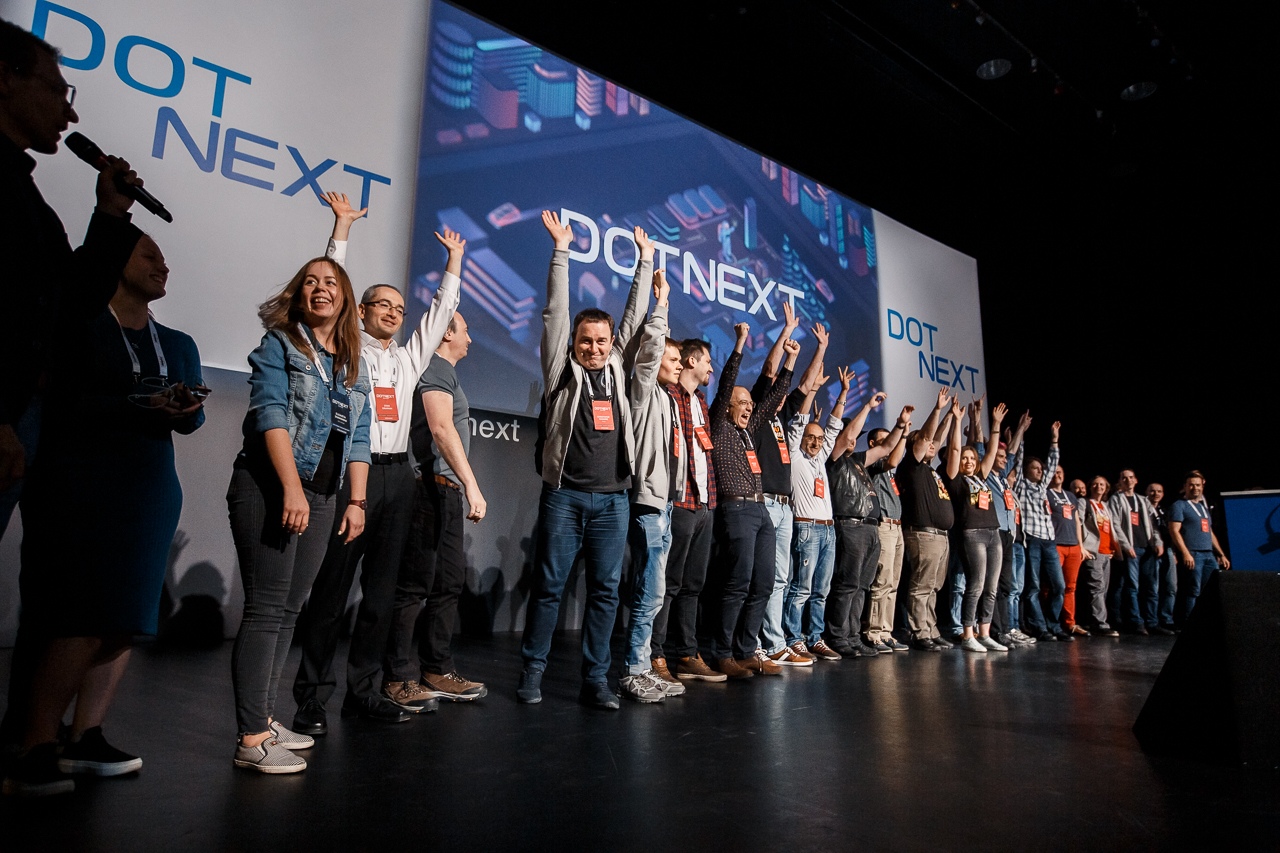
DotNext 2019 Piter has ended. But this also means the start of those invisible processes that precede DotNext 2019 Moscow. Let me remind you once again that it will take place on November 6-7, 2019 at the WTC Congress Center.
If you have something to tell your colleagues - now is the right time to submit a report. Follow the link , there everything is all painted.
And the names of the first speakers are already known.
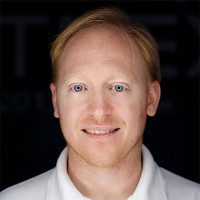 Federico Lois (Corvalius) is a co-founder of R & D of Corvalius, the last ten years has been working on the performance of algorithms, both on the CPU and on a special type of GPU hardware. His experience ranges from managing the performance of banking software to optimizing the database engine. Interests lie in the field of highly-distributed systems, mass-parallel technologies, low-level optimizations and high-performance computer graphics. Here and here is a video of his past reports.
Federico Lois (Corvalius) is a co-founder of R & D of Corvalius, the last ten years has been working on the performance of algorithms, both on the CPU and on a special type of GPU hardware. His experience ranges from managing the performance of banking software to optimizing the database engine. Interests lie in the field of highly-distributed systems, mass-parallel technologies, low-level optimizations and high-performance computer graphics. Here and here is a video of his past reports.
 Jeff Prosise (Wintellect) is a co-founder of Wintellect (along with Jeffrey Richter and John Robbins). He has written nine books and hundreds of articles on software development, and currently spends most of his time working with Azure, building AI solutions and managing WintellectNOW.
Jeff Prosise (Wintellect) is a co-founder of Wintellect (along with Jeffrey Richter and John Robbins). He has written nine books and hundreds of articles on software development, and currently spends most of his time working with Azure, building AI solutions and managing WintellectNOW.
 Victor Gamov (Confluent) is a co-founder of the “Analysis of Flights” podcast, beloved by many programmers. Part-time is the Developer Advocate of Confluent, which develops a platform based on Apache Kafka. Helps clients in the design and development of distributed stream processing systems. Co-author of the book "Enterprise Web Development" publisher O'Reilly.
Victor Gamov (Confluent) is a co-founder of the “Analysis of Flights” podcast, beloved by many programmers. Part-time is the Developer Advocate of Confluent, which develops a platform based on Apache Kafka. Helps clients in the design and development of distributed stream processing systems. Co-author of the book "Enterprise Web Development" publisher O'Reilly.

Topics
Many, I think, have already noticed that DotNext is becoming more and more tolerant to different directions. This time there was a place for architecture, trends, and just good practitioners, which are so often lacking in work. “But what about hardcore ?!” exclaimed hardcore lovers and waved tomatoes. I hasten to reassure, everything is in order with hardcore, it will always have a controlling stake.
Reports
Let me remind you that the full list of reports is still here , in the same place after a while there will be presentations. As for the video, those who filled out the feedback form should have received the link. The rest of the lucky bit less and have to wait until the video will be posted in open access. This usually happens closer to the next conference, which, by the way, will be held on November 6-7 in Moscow, in the WTC Congress Center. But decryption of some reports will appear on the site in the summer, do not miss it!
')
Also, there will definitely be a traditional post from the TOP-10 reports, and we will know the opinion of the majority of participants, but for now I’ll briefly tell you which ones I personally remember.
Mikhail Shcherbakov ( yu5k3 ) "Deserialization vulns: past, present, and future"

Security specialists are always a commodity piece. And such that both deeply, and actually, and the hall did not fall asleep - and at all in the afternoon with fire. Michael put the topic of vulnerabilities in deserializers on the shelves and shared best practices on how to write deserialization safely.
Evgeny Peshkov ( epeshk ) "Multithreading in .NET: when performance is not enough"

Eugene made his debut on DotNext a year ago in St. Petersburg with a report on exceptions, immediately took the first lines of the ratings and now the third conference in a row delivers guts to your
Konstantin Gustov “DDD in microservices: complexity versus complexity”

Konstantin continues to tell the story of the monolith cut, which began last fall at DotNext 2018 Moscow. An excellent report about the practical application of DDD on large applications. Separately, I want to note that over the past six months Kostya has pumped heavily as a speaker.
Roman Nevolin ( nevoroman ) “Why your architecture is functional and how to live with it”

Vagif Abilov ( VagifAbilov ), Maxim Arshinov ( marshinov ) “Life after business objects”

Why did I put two reports next to each other? The functional paradigm is flourishing. More and more features come to C # from the functional world. And both reports about building bridges between paradigms. About how here and now, without switching to F # or, especially, Haskell, to use the advantages that are provided by the functional approach. And this is not only thread safety and scalability, but also, for example, the expressiveness of the code (hello, DDD). In my opinion, the report of Roman was more solid and light, with traditional jokes and trolling. But to argue with yourself is difficult, so the paradigm confrontation is more clearly revealed in the doubles report. And although it is more difficult to prepare such a report by an order of magnitude, Vagif and Maxim got cool.
Dylan Beattie (Skills Matter) "The cost of code"

He closed the keyout program from Dylan Beatty. And this is very correct. Dylan as a magician pulls out of the hat (she won, on the left of the photo) pieces of a mosaic in the form of memes, code, news, facts. And then, when you least expect it, op! magic! and the puzzle develops into the Big Philosophical Thought.
Discussion areas
Usually on reports they try to leave 5-10 minutes for questions from the audience, but sometimes there is so much material that there is not even that. Fortunately, each room has its own discussion zone, in which the speaker and all those who wish to move after the report. You can ask what is called “not for protocol” questions, but you can also ask for an autograph or a photo.


Exhibition and Demo Stage
All the free space between the halls is occupied by the stands of the partners.

A dozen companies have pleased the participants with activities: quests, quizzes, lotteries and, of course, puzzles, where without them.


Murano Software treated everyone to ice cream.

EPAM brought air hockey and pinball.


And Arcadia had something alien at all.

Demo Stage is a separate area where live reports were given by partners, prize draws were also held there.


Dotnetru
At the stand of the All-Russian association .NET-communities DotNetRu had its own extensive program .
At the round tables, everything from Avalonia to DDD was discussed.

Listened to the reports.

And, of course, they played prizes in a quiz and quest.

BOFs and Party
While the future of ASP.NET was discussed at the first BOFE, a hot discussion about .NET 5 flared up at the second: what is new in it, how Mono will live now and why Microsoft does not plan to support CoreRT. Participants also shared their experiences (both positive and not-so) of moving from the classic .NET Framework to the .NET Core.

No less heated discussions were held at this time in the banquet hall.

But the main event of the party was the traditional live performance of DotNext speakers Dylan Beatty, Vagif Abilov and Maxim Arshinov.


Epilogue

DotNext 2019 Piter has ended. But this also means the start of those invisible processes that precede DotNext 2019 Moscow. Let me remind you once again that it will take place on November 6-7, 2019 at the WTC Congress Center.
If you have something to tell your colleagues - now is the right time to submit a report. Follow the link , there everything is all painted.
And the names of the first speakers are already known.
 Federico Lois (Corvalius) is a co-founder of R & D of Corvalius, the last ten years has been working on the performance of algorithms, both on the CPU and on a special type of GPU hardware. His experience ranges from managing the performance of banking software to optimizing the database engine. Interests lie in the field of highly-distributed systems, mass-parallel technologies, low-level optimizations and high-performance computer graphics. Here and here is a video of his past reports.
Federico Lois (Corvalius) is a co-founder of R & D of Corvalius, the last ten years has been working on the performance of algorithms, both on the CPU and on a special type of GPU hardware. His experience ranges from managing the performance of banking software to optimizing the database engine. Interests lie in the field of highly-distributed systems, mass-parallel technologies, low-level optimizations and high-performance computer graphics. Here and here is a video of his past reports. Jeff Prosise (Wintellect) is a co-founder of Wintellect (along with Jeffrey Richter and John Robbins). He has written nine books and hundreds of articles on software development, and currently spends most of his time working with Azure, building AI solutions and managing WintellectNOW.
Jeff Prosise (Wintellect) is a co-founder of Wintellect (along with Jeffrey Richter and John Robbins). He has written nine books and hundreds of articles on software development, and currently spends most of his time working with Azure, building AI solutions and managing WintellectNOW. Victor Gamov (Confluent) is a co-founder of the “Analysis of Flights” podcast, beloved by many programmers. Part-time is the Developer Advocate of Confluent, which develops a platform based on Apache Kafka. Helps clients in the design and development of distributed stream processing systems. Co-author of the book "Enterprise Web Development" publisher O'Reilly.
Victor Gamov (Confluent) is a co-founder of the “Analysis of Flights” podcast, beloved by many programmers. Part-time is the Developer Advocate of Confluent, which develops a platform based on Apache Kafka. Helps clients in the design and development of distributed stream processing systems. Co-author of the book "Enterprise Web Development" publisher O'Reilly.Tickets for the autumn DotNext 2019 Moscow are already on sale , and the lowest price (Early Bird) is valid until June 1 . In addition, all participants of DotNext 2019 Piter had to receive a personal promotional code at the post office, which will make the price even more pleasant. See you in the fall!
Source: https://habr.com/ru/post/454076/
All Articles